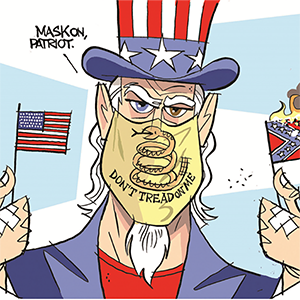Modi's year of setbacks leaves India vulnerable in perilous 2025
Published in News & Features
NEW DELHI, India — At the outset of 2024, Prime Minister Narendra Modi was riding a wave of international acclaim and anticipating an election campaign that looked like such a formality he talked of a thousand-year legacy.
Now, he’s looking back at a year of setbacks — at the ballot box, on the economy, in relations with foreign partners and in India’s own backyard.
Modi’s annus horriblis leaves him on shakier ground going into 2025. Having secured a third term, he now finds himself at the helm of a country whose economy is slowing, with a global image that’s taken a beating from criminal allegations swirling around associates, while his own political standing at home has decidedly weakened.
“It’s been a rockier year than expected,” said Rick Rossow, a senior adviser and South Asia expert at the Center for Strategic and International Studies in Washington. Although Modi fared better than some democratic leaders worldwide, he got “dinged” this year, said Rossow, with the result that his “star has dimmed somewhat.”
An early test of his control is looming with the election expected in January of a new president for his Bharatiya Janata Party, who will wield influence over the political direction of his Hindu nationalist movement, and that of the world’s most populous nation.
Then there’s the arrival of Donald Trump in the White House the same month vowing tariffs on rivals and allies alike. It’s true that many in the Modi government are hopeful of warmer U.S. ties, having always preferred Trump’s transactional approach to bilateral relations than the Biden administration’s more rules-based stance, seeing the latter as prone to hectoring.
At the same time, India ran a trade surplus of some $40 billion with the U.S. last year that risks putting it in Trump’s sights.
‘Ripe Target’
“Because India has a lot of protectionist policies, it’s a ripe target for President Trump,” said Rossow.
That’s a political problem in the making for Modi, 74, and for his continued hold over India’s business community, which has been among his strongest supporters.
India’s financial markets are already losing some of their shine amid the economic uncertainty. Global funds have pulled about $10 billion from local shares since the end of September, set for the biggest quarterly outflow since mid-2022. Bond outflows have also accelerated. The rupee has hit a series of record lows against the dollar in recent weeks.
The prime minister’s office didn’t immediately respond to a request for comment.
Immediate challenges have emerged among India’s neighbors, where political developments moved against New Delhi. Bangladesh — arguably India’s closest regional ally — has become a significant new concern after street protesters overthrew Modi ally Sheikh Hasina. In the Maldives, a pro-China candidate and his party are dominant. In Sri Lanka, where India also vies with China for influence, voters sided with an outsider skeptical of both powers.
At home, violence is on the rise in Jammu and Kashmir, the restive region that Modi brought under his government’s direct control by scrapping its autonomy.
The outlook seemed so much more benign 12 months ago as the prime minister looked ahead to a year of personal political triumph and global ascendancy for India.
He came into 2024 off the back of hosting a successful Group of 20 summit in New Delhi. Up ahead loomed an election that pollsters said was on track to deliver his BJP a landslide victory — and cement his place as India’s most popular leader in decades.
Hindu Temple
He began what looked to be an auspicious period with the inauguration of a huge temple whose construction on the grounds of a demolished mosque in Ayodhya marked the capstone of his Hindu nationalist movement.
“A thousand years from today, people will talk about this date, this moment,” Modi declared in a speech from the temple grounds, as celebrations erupted across India and a national holiday was declared.
Future historians may instead regard it as the high-water mark of Modi’s time in office.
A few months later, India’s annual economic growth topped 8%, giving his party a further boost going into the national elections that kicked off in April. Modi confidently predicted BJP gains and an expanded majority, a development that would allowing sweeping changes to India’s constitution.
The reality check came in June. Humbled by more prosaic concerns like high inflation and unemployment, Modi’s party lost so many seats it was forced to govern with a coalition for the first time in a decade. It reached out to regional parties in Bihar and Andhra Pradesh to do so, making the leaders in those states crucial actors in 2025 — and opening a chink in Modi’s once impenetrable political armor.
“No matter how you slice it, the BJP’s electoral disappointment was a momentum-killer for the Modi juggernaut,” said Michael Kugelman, director of the Wilson Center’s South Asia Institute.
Party President
It’s a dynamic that will play out in the election of a BJP president that represents a test of his hold on the party. His relations are not at their best with the powerful Rashtriya Swayamsevak Sangh, the ideological parent of Modi’s BJP: The RSS criticized the election campaign after the fact for being overly reliant on him. Some of the strongest contenders for the post have a poor working relationship with Modi’s aide Amit Shah, who himself served as BJP president for two terms and who is now minister for home affairs.
Shah was fingered in another setback on the international front. A shocking murder-for-hire program, first revealed in Canada, was at play on American soil — and, according to U.S. authorities, directed with New Delhi’s knowledge. In October came the bombshell that Shah was under scrutiny in the spiraling allegations.
November brought another blow against a Modi ally. U.S. prosecutors accused billionaire Gautam Adani and associates of involvement in a $250 million plot to bribe Indian government officials and lie to investors, allegations that throw the fate of India’s global infrastructure buildout from Kenya to Bhutan into question.
Above all, there’s the economy. Quarterly expansion of 5.4%, the slowest pace since 2022, prompted economists to cut their growth targets. The central bank said it now expects growth of 6.6% for the current fiscal year, down from 7.2%, and flagged a worrying “surge” in inflation.
Incompetence Charge
Those indications of Modi’s economic trouble are further emboldening the main opposition Indian National Congress party after its surprisingly strong showing in the national election.
Below-target growth “robs millions of the opportunity to better their lives or break out of poverty,” said senior Congress member Rajeev Gowda. “It demonstrates the extraordinary incompetence of the government.”
Gowda further cited the negative impact of the allegations against Adani, saying that it’s likely to deter investors. “The opposition wants the government to explain its economic failures and why exemplary action has not been taken to address concerns of cronyism,” he said.
It may all be relative: India remains one of the world’s fastest-growing major economies despite the slowdown.
While Trump called out India on the campaign trail, referring to it as the “biggest charger” of duties on Harley-Davidson Inc. motorcycles and other goods, Indian officials believe his transactional approach will give Modi room to negotiate. External Affairs Minister Subrahmanyam Jaishankar said that Modi’s was among the first calls Trump took after his election victory.
What’s more, there’s a chance for Modi to build personal rapport with Trump, with Indian officials expecting a Trump visit during the second half of 2025 for a summit of countries in the Quad military partnership, comprising India, the U.S., Japan and Australia.
The Indian leader may also be able to burnish his international credentials. After meeting with President Xi Jinping on the sidelines of the BRICS summit in Russia in October, Indian officials expect Modi to travel to China next year for the Shanghai Cooperation Organization summit. Any further breakthrough with China on the mutual dispute in the Himalayas would mark an undeniable success in mending fences with India’s biggest rival.
At home, the loosely cobbled together opposition coalition led by Rahul Gandhi’s Congress is engaged in a bitter power struggle with regional political leaders who want a change in leadership of the alliance barely six months after its show of unity hurt the BJP.
Modi must still navigate a more treacherous political landscape, keeping his coalition intact while finding new causes to mobilize voters. Upcoming elections in the eastern state of Bihar and in the national capital region of Delhi will provide a further test.
His spell over the BJP may have been broken but he remains its biggest asset, and he restored some of his brand with twin victories in two recent state votes. Those campaigns showed the party tilting in a pro-welfare direction, touting cash handouts to women, while the Delhi ballot will allow the BJP to draw attention to the opposition-governed city’s worsening pollution crisis.
“Modi has found a way time and time again to reinvent himself,” said Milan Vaishnav, director of the South Asia Program at the Carnegie Endowment for International Peace. “He has a chameleon-like quality that I think can be very powerful in politics.”
—With assistance from Ravil Shirodkar.
©2024 Bloomberg L.P. Visit bloomberg.com. Distributed by Tribune Content Agency, LLC.







Comments